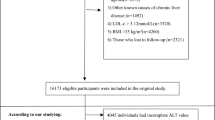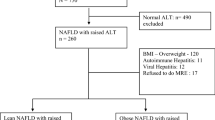Abstract
Background:
Metabolic syndrome (MS) is considered a cause of abnormal deposition of fat into hepatocytes, which might be associated with hepatic steatosis or abnormal liver function.
Objective:
The aim of this study was to explore the factors associated with MS and the relationship between MS and abnormal aspartate aminotransferase (AST), alanine aminotransferase (ALT) and γ-glutamyl transferase (GGT) levels in Taiwanese subjects without chronic hepatitis B (CHB) or C (CHC).
Subjects:
We enrolled 2539 Taiwanese adults without CHB or CHC (age range: 16–88 years old) and investigated the factors related to MS using the NCEP-ATP (National Cholesterol Education Program-Adult Treatment Panel) III criteria; body mass index (BMI) was measured using Asia-Pacific criteria.
Results:
The prevalence rate of MS in Taiwanese adults without CHB or CHC was 16.9% using the modified ATP III criteria and 15.4% using the International Diabetes Federation criteria. Males had a significantly higher prevalence rate than females (P<0.001), and subjects with MS were significantly older and had significantly higher BMI values and AST, ALT and GGT levels (all P<0.001). In univariate analyses, the abnormality of liver function test results were related to gender, level of fasting sugar, systolic blood pressure, triglyceride, high-density lipoprotein, BMI and MS (all P<0.05). Multivariate analysis showed that the male gender, a higher BMI value and MS were related to abnormal liver function test results. The cutoff value for ALT in relation to MS is 31 IU l−1 for male and 18 IU l−1 for female.
Conclusion:
The prevalence of MS in Taiwanese adults without hepatitis B or C was found to be high, and MS and BMI were identified as being related to abnormal liver function test results in these adults.
This is a preview of subscription content, access via your institution
Access options
Subscribe to this journal
Receive 12 print issues and online access
$259.00 per year
only $21.58 per issue
Buy this article
- Purchase on Springer Link
- Instant access to full article PDF
Prices may be subject to local taxes which are calculated during checkout

Similar content being viewed by others
References
Isomaa B, Almgren P, Tuomi T, Forsen B, Lahti K, Nissen M et al. Cardiovascular morbidity and mortality associated with the metabolic syndrome. Diabetes Care 2001; 24: 683–689.
Lakka HM, Laaksonen DE, Lakka TA, Niskanen LK, Kumpusalo E, Tuomilehto J et al. The metabolic syndrome and total and cardiovascular disease mortality in middle-aged men. JAMA 2002; 288: 2709–2716.
Hanson RL, Imperatore G, Bennett PH, Knowler WC . Components of the ‘metabolic syndrome’ and incidence of type 2 diabetes. Diabetes 2002; 51: 3120–3127.
Boyko EJ, de Courten M, Zimmet PZ, Chitson P, Tuomilehto J, Alberti KG . Features of the metabolic syndrome predict higher risk of diabetes and impaired glucose tolerance: a prospective study in Mauritius. Diabetes Care 2000; 23: 1242–1248.
Wilson PW, D'Agostino RB, Parise H, Sullivan L, Meigs JB . Metabolic syndrome as a precursor of cardiovascular disease and type 2 diabetes mellitus. Circulation 2005; 112: 3066–3072.
Grundy SM . Metabolic syndrome: a multiplex cardiovascular risk factor. J Clin Endocrinol Metab 2007; 92: 399–404.
Gami AS, Witt BJ, Howard DE, Erwin PJ, Gami LA, Somers VK et al. Metabolic syndrome and risk of incident cardiovascular events and death: a systematic review and meta-analysis of longitudinal studies. J Am Coll Cardiol 2007; 49: 403–414.
Laaksonen DE, Lakka HM, Niskanen LK, Kaplan GA, Salonen JT, Lakka TA . Metabolic syndrome and development of diabetes mellitus: application and validation of recently suggested definitions of the metabolic syndrome in a prospective cohort study. Am J Epidemiol 2002; 156: 1070–1077.
National Cholesterol Education Program (NCEP) Expert Panel on Detection, Evaluation, and Treatment of High Blood Cholesterol in Adults (Adult Treatment Panel III). Third Report of the National Cholesterol Education Program (NCEP) Expert Panel on Detection, Evaluation, and Treatment of High Blood Cholesterol in Adults (Adult Treatment Panel III) final report. Circulation 2002; 106: 3143–3421.
Grundy SM . Hypertriglyceridemia, insulin resistance, and the metabolic syndrome. Am J Cardiol 1999; 83 (9B): 25F–29F.
Unwin N . The metabolic syndrome. J R Soc Med 2006; 99: 457–462.
Miyatake N, Matsumoto S, Makino H, Numata T . Comparison of hepatic enzymes between Japanese men with and without metabolic syndrome. Acta Med Okayama 2007; 61: 31–34.
Wannamethee SG, Shaper AG, Lennon L, Whincup PH . Hepatic enzymes, the metabolic syndrome, and the risk of type 2 diabetes in older men. Diabetes Care 2005; 28: 2913–2918.
Nannipieri M, Gonzales C, Baldi S, Posadas R, Williams K, Haffner SM et al. Liver enzymes, the metabolic syndrome, and incident diabetes: the Mexico City diabetes study. Diabetes Care 2005; 28: 1757–1762.
Hsiao PJ, Kuo KK, Shin SJ, Yang YH, Lin WY, Yang JF et al. Significant correlations between severe fatty liver and risk factors for metabolic syndrome. J Gastroenterol Hepatol 2007; 22: 2118–2123.
Tsai CH, Li TC, Lin CC . Metabolic syndrome as a risk factor for nonalcoholic fatty liver disease. South Med J 2008; 101: 900–905.
Lai SW, Liao KF, Li TC, Lin HF, Lin WY, Lin CH . Metabolic syndrome in older people in Taiwan: a hospital-based study. Intern Med J 2006; 36: 648–651.
Hwang LC, Bai CH, Chen CJ . Prevalence of obesity and metabolic syndrome in Taiwan. J Formos Med Assoc 2006; 105: 626–635.
[Revised Diagnostic Criteria of Metabolic Syndrome for adults aged more or equal 20 years old in Taiwan, 2006]. In: Bureau of Health Promotion. Department of Health: Taipei, ROC (Taiwan).
Jia WP, Xiang KS, Chen L, Lu JX, Wu YM . Epidemiological study on obesity and its comorbidities in urban Chinese older than 20 years of age in Shanghai, China. Obes Rev 2002; 3: 157–165.
Gill TP . Cardiovascular risk in the Asia-Pacific region from a nutrition and metabolic point of view: abdominal obesity. Asia Pac J Clin Nutr 2001; 10: 85–89.
Alberti KG, Zimmet P, Shaw J . The metabolic syndrome—a new worldwide definition. Lancet 2005; 366: 1059–1062.
Chang CJ, Wu CH, Chang CS, Yao WJ, Yang YC, Wu JS et al. Low body mass index but high percent body fat in Taiwanese subjects: implications of obesity cutoffs. Int J Obes Relat Metab Disord 2003; 27: 253–259.
Saito T, Misawa K, Kawata S . 1. Fatty liver and non-alcoholic steatohepatitis. Intern Med 2007; 46: 101–103.
Schindhelm RK, Diamant M, Dekker JM, Tushuizen ME, Teerlink T, Heine RJ . Alanine aminotransferase as a marker of non-alcoholic fatty liver disease in relation to type 2 diabetes mellitus and cardiovascular disease. Diabetes Metab Res Rev 2006; 22: 437–443.
Younossi ZM, McCullough AJ, Ong JP, Barnes DS, Post A, Tavill A et al. Obesity and non-alcoholic fatty liver disease in chronic hepatitis C. J Clin Gastroenterol 2004; 38: 705–709.
Kawai N, Kawai T, Kawai K . Ultrasonic and laboratory studies on fatty liver in white-collar workers. Nippon Shokakibyo Gakkai Zasshi 1995; 92: 1058–1065.
Lonardo A, Bellini M, Tartoni P, Tondelli E . The bright liver syndrome. Prevalence and determinants of a ‘bright’ liver echo pattern. Ital J Gastroenterol Hepatol 1997; 29: 351–356.
Ionescu DL . Microvesicular steatosis. Rev Med Chir Soc Med Nat Iasi 2002; 107: 268–272.
De Luis DA, Aller R, Izaola O, Gonzalez Sagrado M, Conde R, Gonzalez Hernandez JM . Influence of insulin resistance in obese patients on elevated serum alanine aminotransferase. Eur Rev Med Pharmacol Sci 2007; 11: 21–25.
Kim WR, Flamm SL, Di Bisceglie AM, Bodenheimer HC . Serum activity of alanine aminotransferase (ALT) as an indicator of health and disease. Hepatology 2008; 47: 1363–1370.
Keeffe EB, Dieterich DT, Han SH, Jacobson IM, Martin P, Schiff ER et al. A treatment algorithm for the management of chronic hepatitis B virus infection in the United States: an update. Clin Gastroenterol Hepatol 2006; 4: 936–962.
Prati D, Taioli E, Zanella A, Della Torre E, Butelli S, Del Vecchio E et al. Updated definitions of healthy ranges for serum alanine aminotransferase levels. Ann Intern Med 2002; 137: 1–10.
Lok AS, McMahon BJ . Chronic hepatitis B. Hepatology 2007; 45: 507–539.
Yuen MF, Yuan HJ, Wong DK, Yuen JC, Wong WM, Chan AO et al. Prognostic determinants for chronic hepatitis B in Asians: therapeutic implications. Gut 2005; 54: 1610–1614.
Lai M, Hyatt BJ, Nasser I, Curry M, Afdhal NH . The clinical significance of persistently normal ALT in chronic hepatitis B infection. J Hepatol 2007; 47: 760–767.
Michelle Lai BH . Role of liver biopsy in patients with normal ALT and high HBV DNA. Hepatology 2005; 42 (Suppl 1): 720A.
Alberti A, Noventa F, Benvegnu L, Boccato S, Gatta A . Prevalence of liver disease in a population of asymptomatic persons with hepatitis C virus infection. Ann Intern Med 2002; 137: 961–964.
Kim HC, Nam CM, Jee SH, Han KH, Oh DK, Suh I . Normal serum aminotransferase concentration and risk of mortality from liver diseases: prospective cohort study. BMJ 2004; 328: 983.
Wang Z, Hall SD, Maya JF, Li L, Asghar A, Gorski JC . Diabetes mellitus increases the in vivo activity of cytochrome P450 2E1 in humans. Br J Clin Pharmacol 2003; 55: 77–85.
Acknowledgements
This study was supported by grants from the Taiwan Liver Research Foundation, the Department of Preventive Medicine, Chung-Ho Memorial Hospital, Kaohsiung Medical University and the Health Examination Center, Kaohsiung Municipal Hsiaokang Hospital, Taiwan.
Author information
Authors and Affiliations
Corresponding author
Rights and permissions
About this article
Cite this article
Hsieh, MH., Ho, CK., Hou, NJ. et al. Abnormal liver function test results are related to metabolic syndrome and BMI in Taiwanese adults without chronic hepatitis B or C. Int J Obes 33, 1309–1317 (2009). https://doi.org/10.1038/ijo.2009.172
Received:
Revised:
Accepted:
Published:
Issue Date:
DOI: https://doi.org/10.1038/ijo.2009.172
Keywords
This article is cited by
-
Association between serum iron and liver transaminases based on a large adult women population
Journal of Health, Population and Nutrition (2023)
-
Association between liver function and metabolic syndrome in Chinese men and women
Scientific Reports (2017)
-
Inflammation and Biochemical Features of Bariatric Candidates: Does Gender Matter?
Obesity Surgery (2011)



